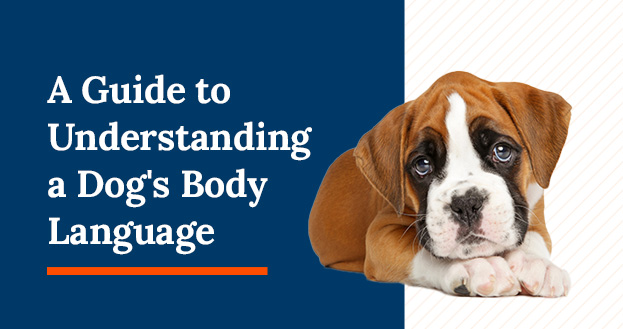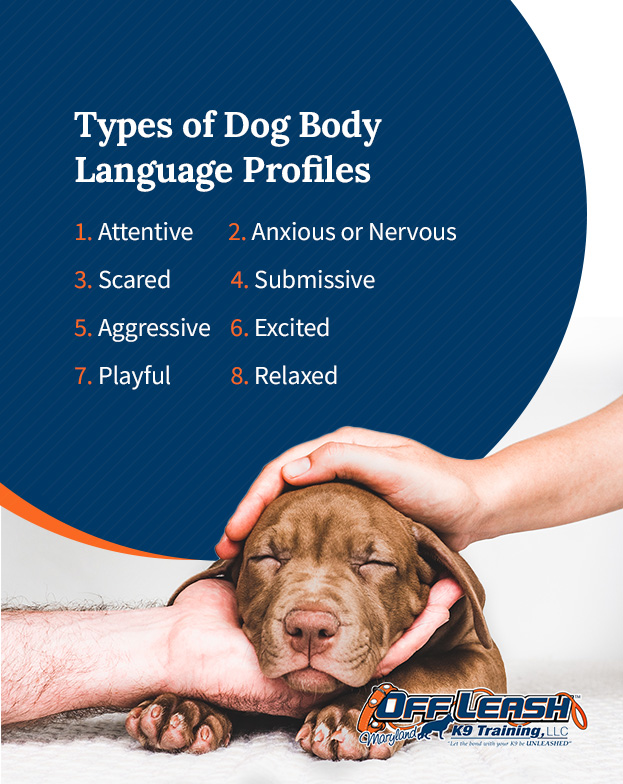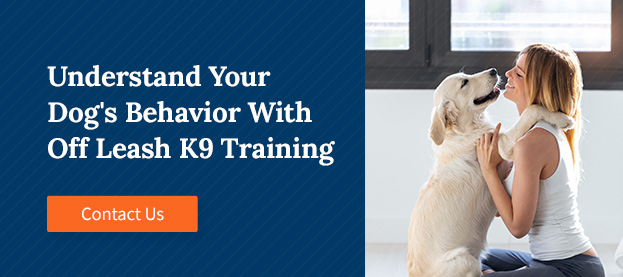Table of Contents
- Types of Dog Body Language Profiles
- Facial Expressions
- Tail Positioning
- Deciphering Body Language
- Understand Your Dog’s Behavior With Off Leash K9 Training
Most of us are familiar with the more common ways dogs communicate. We recognize their barks, whines and growls. However, there is much more to understanding what your dog is thinking or feeling than the sounds they make. The body language your dog displays can also be a huge help with comprehending the message they are trying to convey.
Even so, certain actions that humans think mean one thing can often mean another in dog body language. Learning the differences is easy. Discover how to read your dog’s behavior and strengthen the communication between you and your canine companion with this article.
Types of Dog Body Language Profiles
When it comes to understanding dogs, there are some key aspects of basic dog body language to remember. Here are eight basic profiles that demonstrate certain feelings dogs experience:
1. Attentive
Attentiveness is most commonly seen in a dog that has heard a new sound. A dog may also show attentiveness if they cannot identify a sound or see something move in their field of vision.
2. Anxious or Nervous
Dogs that have been caught doing something they know they shouldn’t be doing often demonstrate anxiousness or nervousness. This emotion can also be seen in dogs when they experience some sort of new stimuli they are unfamiliar with.
3. Scared
You may notice specific behaviors in a dog that feels scared, such as growling, cowering and lip licking. A dog exhibiting these actions may feel like something is threatening its safety.
4. Submissive
A dog may demonstrate submissiveness through lowering their head or putting their tail between their legs in situations where they are being stared down by another more dominant dog, animal or human.
5. Aggressive
Dogs typically show aggression when they feel threatened and are trying to make the threat go away. This behavior, such as growling, lunging and biting, is commonly seen in dogs that have poor socialization skills or have suffered abuse.
6. Excited
When your dog runs to greet you at the door after you have been gone for a while or jumps up and down when about to get their favorite treat, they are generally expressing excitement.
7. Playful
A dog that’s ready to play will demonstrate certain behaviors such as bringing you their ball for you to throw. They may also show playfulness when you bring them a new toy by playfully mouthing your hand or wagging their tail.
8. Relaxed
A relaxed dog is often a sleepy-looking dog. You can tell when your dog is relaxed by observing their comfort with their surroundings, which is shown by panting with no facial tension. Their mouth may turn upward slightly in a doggy grin.
Facial Expressions
Facial expressions can be a great method of understanding dogs. While we may think we know what actions like yawning mean, we may not truly understand it in the context of a dog’s actions. A couple common expressions include:
Yawning
We know why we yawn as humans, but what does yawning mean in dog body language? Does it really mean your furry friend is sleepy or bored? Yawning can actually be a sign that your dog is nervous, stressed or even excited. If it’s been a long day, they could just be tired and trying to relax from everything.
Dogs often use yawning to calm themselves down, which is why you’ll often see them yawning if they are excited or nervous. The next time your pooch begins to yawn, note the situation and surroundings. They could be showing you that they are excited to see their leash or favorite treat bag or to meet new people.
Yawning could also be a sign they are a bit overwhelmed. Paying attention to these instances and learning how to read dog behavior can help you make your dog feel more comfortable by identifying their needs.
Licking Their Lips
If you think your dog licks their lips to indicate hunger, you’re right. There are also other reasons why they could be licking their lips that have nothing to do with food. Much like yawning, dogs tend to lick their lips to calm themselves. If you notice your dog is licking their lips, consider what’s happening around them. If there is no food involved, they could be bothered by a situation such as having their paws handled, getting a bath or going to the veterinarian’s office.
Tail Positioning
You can learn a lot about a dog’s mood by understanding its tail positioning. Tail wagging may seem simple to us, but dogs’ tails can tell us much more.
A dog with a fast-wagging tail is an aroused dog. In most cases, the faster their tail wags, the more excited they are — like when they greet you at the door. A dog displaying long, slow, side-to-side tail wags that make their whole body wag is generally pretty relaxed. If a dog shows a fast, twitching wag, this could mean they are on high alert.
The direction of the tail can also help you understand your dog’s feelings. If your dog holds its wagging tail more to the right, this could mean they are experiencing positive feelings. A tail wagging more to the left can show your dog is feeling something negative. If your dog swings their tail around in a circle like a helicopter, they are undoubtedly happy.
With dog tail language, pay attention to the distance a dog holds their tail from the ground. Dogs that hold their tails low to the ground or tucked between their legs are likely scared or stressed. If your dog holds its tail up like a flag, it could be feeling confident or even aggressive in some cases. A relaxed dog will usually hold its tail in a neutral position.
Deciphering Body Language
By noticing your dog’s combined body language, you can better read your dog’s behavior. Paying attention to their tail and facial expressions in addition to their surroundings can help you determine if they are excited, stressed, happy or scared. Comprehending dog body language can help you create a better bond with your companion and even assist you in interacting with new dogs.
Understand Your Dog’s Behavior With Off Leash K9 Training
Off Leash K9 Training offers experienced and compassionate training for your dog. We provide one-on-one sessions with your dog to ensure they get the personalized attention they need. You can choose from various training options customized by our skilled trainers. Whether your dog needs a little help with its manners, could use some leash training or needs some guidance with socialization, we are here to help. Contact us today to see how we can help you and your canine companion.



